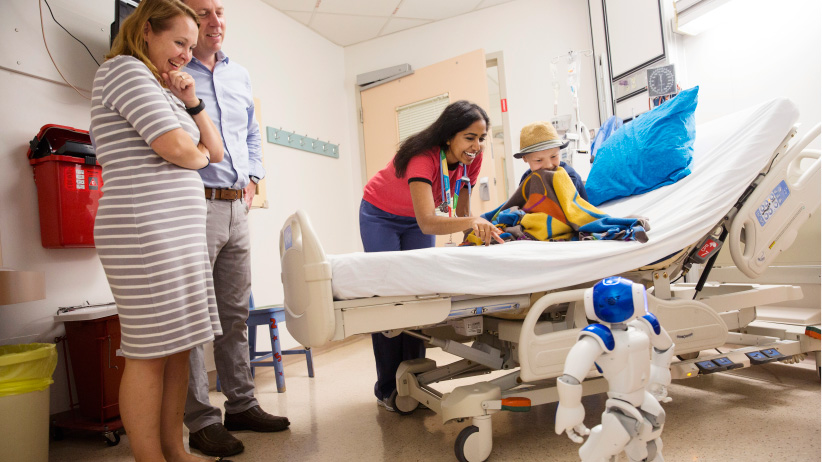The University of Toronto’s nursing program: VR, robots and more
University of Toronto students research robots and games to mitigate pain
James Hack, 8 years, sits with Nurse Tessy George (left) and his mother Heather Hack as he interacts with MEDi the robot who can sit, stand, sing, tell stories and dance as he receives chemotherapy at SickKids Hospital in Toronto on September 27, 2017. As part of a recent research study MEDi (Medicine and Engineering Designing Intelligence) has been introduced to young oncology patients in hopes to reduce anxieties and stress around medical procedures. (Michelle Siu for Maclean’s)
Share
[widgets_on_pages id=”university_guide_global_forever_header”]
[widgets_on_pages id=”university_guide_2018_intro_header”]

Students in the nursing program at the University of Toronto benefit from being at the epicentre of medical research in Canada. Toronto is home to more than 40 hospitals, many of them doubling as medical research facilities or teaching schools affiliated with U of T.
While the two-year compressed nursing program is fast-paced and jam-packed, ambitious students can take advantage of their location by contributing to some of the exciting research happening both on and near campus.
Every year, a few dozen students are accepted into the summer student research program, some of whom land a spot in Jennifer Stinson’s lab. “The whole focus of our research is how we can use digital health technologies to help young people with painful chronic conditions,” says Stinson, a faculty member at U of T’s Lawrence S. Bloomberg Faculty of Nursing, who also runs the iOuch lab at SickKids Hospital. One recent pilot project supported by Stinson’s student nurses was MEDi, a humanoid robot that distracts children—by either dancing or giving verbal coaching—as they’re receiving chemo treatment, often a painful and distressing procedure. In another project, students worked on interventions that use virtual reality and gamification to distract adolescents when they’re having painful procedures done as part of their cancer treatment.

Margaret van Wyk worked in Stinson’s lab after graduating from a health science program at Western University. At Western, she was quickly inspired to get a nursing degree of her own. Now, less than a year after graduating, she is a registered nurse at SickKids. While van Wyk eventually wants to return to research—or a combination of research and clinical work—she knows that bedside experience is critical to being a good researcher. “It’s an opportunity to see where research questions are formulated,” she says. “It gives you a different respect for how studies are integrated into patient care on the unit.”
The opposite is also true: “As a practising nurse, even if you’re not working in research, you should be able to understand basic studies and how to interpret them,” van Wyk adds. “U of T plays a large role in helping students with that, through their curriculum and research opportunities.”
While it’s certainly valuable for students to get exposure to cutting-edge research, it’s not the only advantage to studying at U of T. The compressed program means students are placed into a clinical setting after less than two weeks of classroom and lab time. “What we hear from students is that they like it because it lets them know right away whether they’re in the right place,” says Maureen Barry, a nurse and professor in the program. Indeed, the vast majority of students enter the program with an undergraduate degree (the school requires at least two years of undergrad under their belt) and are eager to get into the workforce.
Those clinical sessions continue in rapid succession throughout the program. Students complete eight of them in total, each one ranging from four to 12 weeks, in settings that span mental health, community health, pediatrics, oncology and maternity care, to name just a few. They wrap up the program with a three-month practicum where they shadow another nurse in the field.
[widgets_on_pages id=”university_guide_2018_outro_footer”]
MORE ABOUT NURSING:
- Top 10 Nursing Universities
- Nurses rule the job boards
- Health, engineering degrees have best return: Workopolis
- Halifax nurses ordered to get back to work
- UNB nursing students say strike could derail career plans
- Quebec nurses won’t need degrees
- Health care workers may be immune to unemployment
- Campus life at Trent University